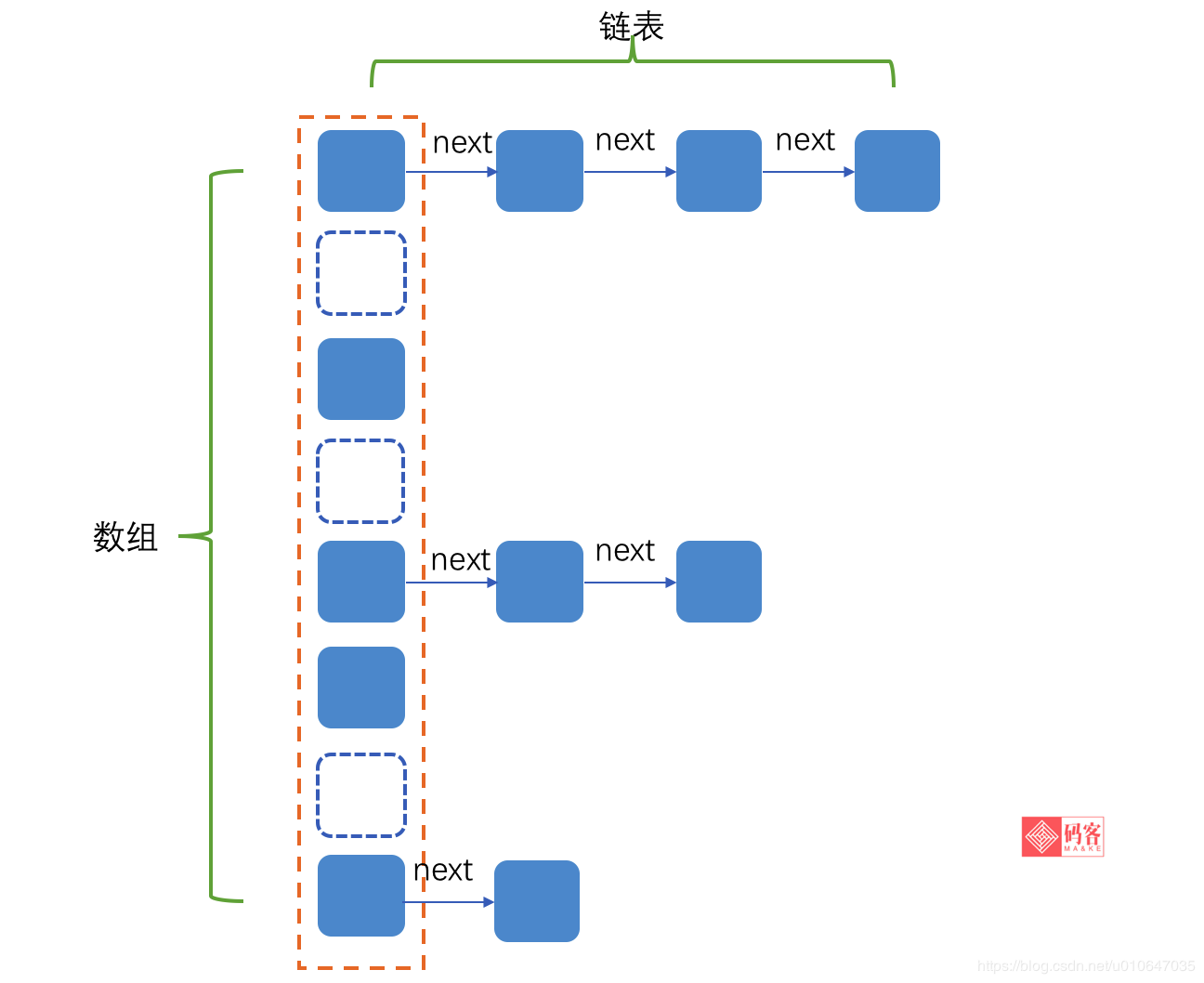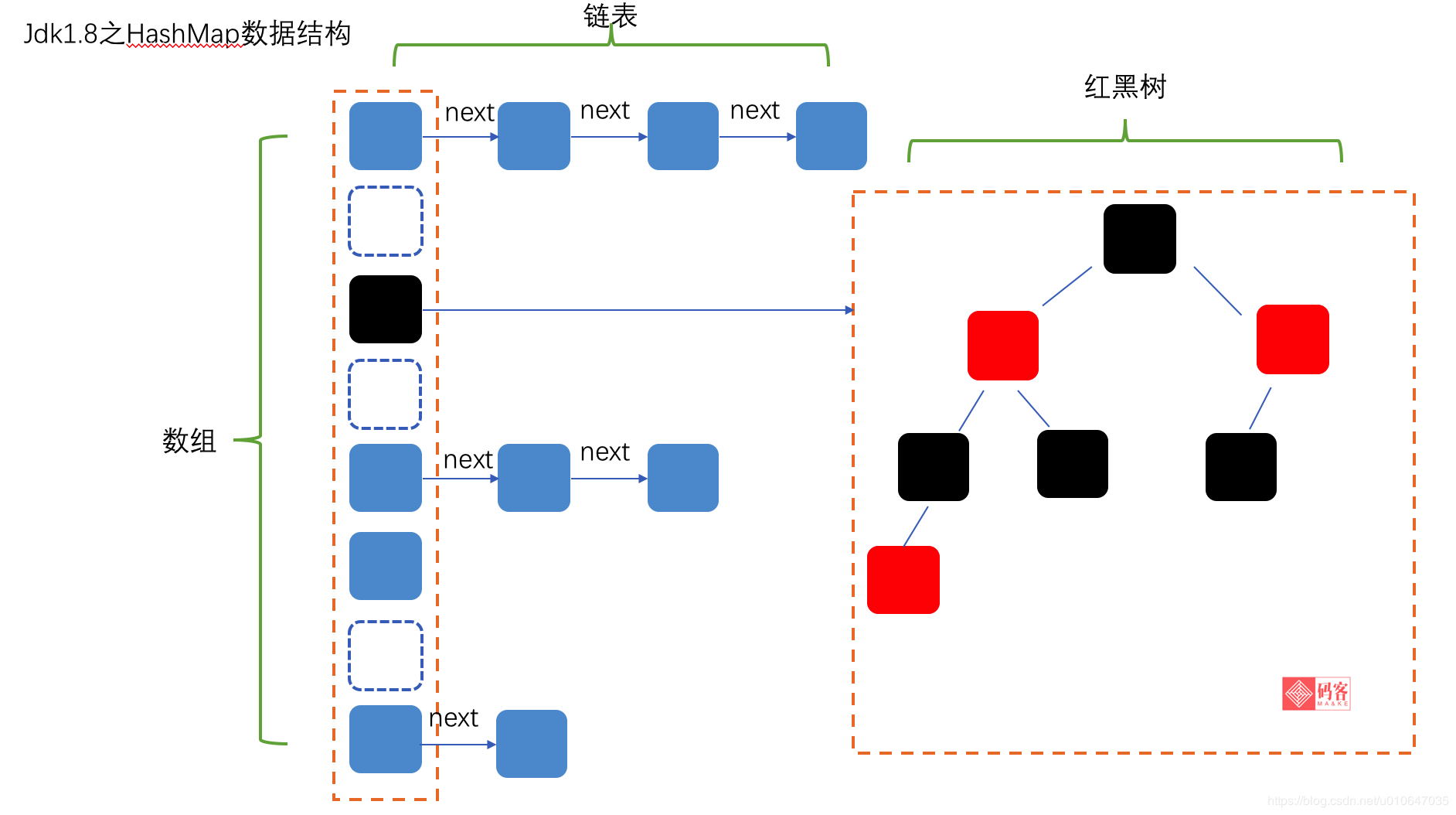HashMap简述
HashMap是工作中最常用的集合工具之一,在整个集合框架中也是很重要的一部分,因此本篇文章主要讲述它的底层实现原理,因为jdk1.8中对HashMap的数据结构有了修改,所以本篇将会分别讲解jdk1.7和jdk1.8中HashMap的区别,通过对比学习来加深对HashMap的理解
jdk1.8之前HashMap采用【数组+链表】实现,使用链表处理hash冲突,同一个hash值都存在一个链表里。但是当存储的元素较多时,hash值相等的元素也会增多,通过key值依次查找的效率就降低了许多。
jdk1.8中,HashMap采用【数组+链表+红黑树】实现,当链表长度超过8时,将链表转换为红黑树,这样就大大提高的查找的时间
HashMap数据结构
JDK1.7中HashMap数据结构

HashMap中的数组即为嵌套类Entry,数组中的每个元素是一个单项链表,每个Entry包含四个属性:
🌂key, value, hash 值和用于单向链表的 next。
🌂capacity:当前数组容量,始终保持 2^n,可以扩容,扩容后数组大小为当前的 2 倍。
🌂loadFactor:负载因子,默认为 0.75。
🌂threshold:扩容的阈值,等于 capacity * loadFactor
1
2
3
4
5
6
7
| static class Entry<K,V> implements Map.Entry<K,V> {
final K key;
V value;
Entry<K,V> next;
int hash;
.....................................
}
|
JDK1.8中HashMap数据结构

Java8 对 HashMap 做了一些修改,最大的不同就是利用了红黑树,所以其由 【数组+链表+红黑树】 组成。
我们知道,Java7 HashMap查找的时候,根据 hash 值我们能够快速定位到数组的具体下标,但是之后,需要顺着链表一个个比较下去才能找到我们需要的,时间复杂度取决于链表的长度,为 O(n)。
为了降低这部分的开销,在 Java8 中,当链表中的元素超过了 8 个以后,会将链表转换为红黑树,在进行查找的时候可以降低时间复杂度为 O(logN)。
Java7 中使用 Entry 来代表每个 HashMap 中的数据元素,Java8 中使用 Node,都是** key,value,hash** 和 next 这四个属性,不过,Node 只能用于链表的情况,红黑树的情况需要使用 TreeNode
1
2
3
4
5
6
7
8
9
10
11
12
13
14
| static class Node<K,V> implements Map.Entry<K,V> {
final int hash;
final K key;
V value;
Node<K,V> next;
Node(int hash, K key, V value, Node<K,V> next) {
this.hash = hash;
this.key = key;
this.value = value;
this.next = next;
}
...............................................
}
|
HashMap存取值分析
HashMap存值(put)分析【JDK1.7】
HashMap存值源码走读【JDK1.7】
transient Entry<K,V>[] table = (Entry<K,V>[]) EMPTY_TABLE;
1
2
3
4
5
6
7
8
9
10
11
12
13
14
15
16
17
18
19
20
21
22
23
24
25
26
27
28
29
| public V put(K key, V value) {
if (table == EMPTY_TABLE) {
inflateTable(threshold);
}
if (key == null)
return putForNullKey(value);
int hash = hash(key);
int i = indexFor(hash, table.length);
for (Entry<K, V> e = table[i]; e != null; e = e.next) {
Object k;
if (e.hash == hash && ((k = e.key) == key || key.equals(k))) {
V oldValue = e.value;
e.value = value;
e.recordAccess(this);
return oldValue;
}
}
modCount++;
addEntry(hash, key, value, i);
return null;
}
|
HashMap数组初始化【JDK1.7】
当第一个元素插入时,会初始化数组,计算数组的初始化大小及扩容阈值
1
2
3
4
5
6
7
8
9
10
| private void inflateTable(int toSize) {
int capacity = roundUpToPowerOf2(toSize);
threshold = (int) Math.min(capacity * loadFactor, MAXIMUM_CAPACITY + 1);
table = new Entry[capacity];
initHashSeedAsNeeded(capacity);
}
|
HashMap元素存放位置计算【JDK1.7】
使用key的hash值与数组长度大小减一取模
1
2
3
4
| static int indexFor(int h, int length) {
return h & (length-1);
}
|
HashMap添加元素到链表【JDK1.7】
先判断key值是否重复,如果不重复添加新元素到链表,添加之前先判断是否需要扩容,如果需要则先扩容,重新计算hash,然后再将新元素存入对应链表的表头
1
2
3
4
5
6
7
8
9
10
11
12
13
14
15
16
17
18
19
| void addEntry(int hash, K key, V value, int bucketIndex) {
if ((size >= threshold) && (null != table[bucketIndex])) {
resize(2 * table.length);
hash = (null != key) ? hash(key) : 0;
bucketIndex = indexFor(hash, table.length);
}
createEntry(hash, key, value, bucketIndex);
}
void createEntry(int hash, K key, V value, int bucketIndex) {
Entry<K,V> e = table[bucketIndex];
table[bucketIndex] = new Entry<>(hash, key, value, e);
size++;
}
|
HashMap数组扩容【JDK1.7】
在插入新值的时候,如果当前的 size 已经达到了阈值,并且要插入的数组位置已经有元素,就会触发扩容,扩容后,数组大小为原来的 2 倍。
扩容就是用一个新的大数组替换原来的小数组,并将原来数组中的值迁移到新的数组中
1
2
3
4
5
6
7
8
9
10
11
12
13
14
15
| void resize(int newCapacity) {
Entry[] oldTable = table;
int oldCapacity = oldTable.length;
if (oldCapacity == MAXIMUM_CAPACITY) {
threshold = Integer.MAX_VALUE;
return;
}
Entry[] newTable = new Entry[newCapacity];
transfer(newTable, initHashSeedAsNeeded(newCapacity));
table = newTable;
threshold = (int)Math.min(newCapacity * loadFactor, MAXIMUM_CAPACITY + 1);
}
|
JDK1.7取值(get)分析
相对于存值(put),HashMap取值相对简单,大致逻辑为:
🌂根据key计算hash
🌂使用key的hash值与数组长度取模(length-1)得到元素存储位置下标
🌂遍历数组中在该下标处的链表,直到找到相等的key
1
2
3
4
5
6
7
8
9
10
11
12
13
14
15
16
17
18
19
20
21
22
23
24
25
26
27
28
29
30
31
32
33
34
35
36
37
38
39
| public V get(Object key) {
if (key == null)
return getForNullKey();
Entry<K,V> entry = getEntry(key);
return null == entry ? null : entry.getValue();
}
private V getForNullKey() {
if (size == 0) {
return null;
}
for (Entry<K,V> e = table[0]; e != null; e = e.next) {
if (e.key == null)
return e.value;
}
return null;
}
final Entry<K,V> getEntry(Object key) {
if (size == 0) {
return null;
}
int hash = (key == null) ? 0 : hash(key);
for (Entry<K,V> e = table[indexFor(hash, table.length)];
e != null;
e = e.next) {
Object k;
if (e.hash == hash &&
((k = e.key) == key || (key != null && key.equals(k))))
return e;
}
return null;
}
|
HashMap存值(put)分析【JDK1.8】
HashMap存值(put)源码走读【JDK1.8】
相对于jdk1.7中HashMap存值,jdk1.8的逻辑相对复杂,因为需要判断数据节点类型是链表还是红黑树,然后使用对应的方法进行查找
1
2
3
4
5
6
7
8
9
10
11
12
13
14
15
16
17
18
19
20
21
22
23
24
25
26
27
28
29
30
31
32
33
34
35
36
37
38
39
40
41
42
43
44
45
46
47
48
49
50
51
52
53
54
55
56
57
58
59
60
61
62
63
64
65
66
67
| public V put(K key, V value) {
return putVal(hash(key), key, value, false, true);
}
final V putVal(int hash, K key, V value, boolean onlyIfAbsent,
boolean evict) {
Node<K,V>[] tab; Node<K,V> p; int n, i;
if ((tab = table) == null || (n = tab.length) == 0)
n = (tab = resize()).length;
if ((p = tab[i = (n - 1) & hash]) == null)
tab[i] = newNode(hash, key, value, null);
else {
Node<K,V> e; K k;
if (p.hash == hash &&
((k = p.key) == key || (key != null && key.equals(k))))
e = p;
else if (p instanceof TreeNode)
e = ((TreeNode<K,V>)p).putTreeVal(this, tab, hash, key, value);
else {
for (int binCount = 0; ; ++binCount) {
if ((e = p.next) == null) {
p.next = newNode(hash, key, value, null);
if (binCount >= TREEIFY_THRESHOLD - 1)
treeifyBin(tab, hash);
break;
}
if (e.hash == hash &&
((k = e.key) == key || (key != null && key.equals(k))))
break;
p = e;
}
}
if (e != null) {
V oldValue = e.value;
if (!onlyIfAbsent || oldValue == null)
e.value = value;
afterNodeAccess(e);
return oldValue;
}
}
++modCount;
if (++size > threshold)
resize();
afterNodeInsertion(evict);
return null;
}
|
HashMap数组扩容【JDK1.8】
resize() 方法用于初始化数组或数组扩容,初始化时使用默认容量(16)和默认阈值(0.74*16),后来扩容时,容量为原来的 2 倍,并进行数据迁移
1
2
3
4
5
6
7
8
9
10
11
12
13
14
15
16
17
18
19
20
21
22
23
24
25
26
27
28
29
30
31
32
33
34
35
36
37
38
39
40
41
42
43
44
45
46
47
48
49
50
51
52
53
54
55
56
57
58
59
60
61
62
63
64
65
66
67
68
69
70
71
72
73
74
75
76
77
78
79
80
81
82
83
84
85
86
87
88
89
90
91
92
93
| final Node<K,V>[] resize() {
Node<K,V>[] oldTab = table;
int oldCap = (oldTab == null) ? 0 : oldTab.length;
int oldThr = threshold;
int newCap, newThr = 0;
if (oldCap > 0) {
if (oldCap >= MAXIMUM_CAPACITY) {
threshold = Integer.MAX_VALUE;
return oldTab;
}
else if ((newCap = oldCap << 1) < MAXIMUM_CAPACITY &&
oldCap >= DEFAULT_INITIAL_CAPACITY)
newThr = oldThr << 1;
}
else if (oldThr > 0)
newCap = oldThr;
else {
newCap = DEFAULT_INITIAL_CAPACITY;
newThr = (int)(DEFAULT_LOAD_FACTOR * DEFAULT_INITIAL_CAPACITY);
}
if (newThr == 0) {
float ft = (float)newCap * loadFactor;
newThr = (newCap < MAXIMUM_CAPACITY && ft < (float)MAXIMUM_CAPACITY ?
(int)ft : Integer.MAX_VALUE);
}
threshold = newThr;
Node<K,V>[] newTab = (Node<K,V>[])new Node[newCap];
table = newTab;
if (oldTab != null) {
for (int j = 0; j < oldCap; ++j) {
Node<K,V> e;
if ((e = oldTab[j]) != null) {
oldTab[j] = null;
if (e.next == null)
newTab[e.hash & (newCap - 1)] = e;
else if (e instanceof TreeNode)
((TreeNode<K,V>)e).split(this, newTab, j, oldCap);
else {
Node<K,V> loHead = null, loTail = null;
Node<K,V> hiHead = null, hiTail = null;
Node<K,V> next;
do {
next = e.next;
if ((e.hash & oldCap) == 0) {
if (loTail == null)
loHead = e;
else
loTail.next = e;
loTail = e;
}
else {
if (hiTail == null)
hiHead = e;
else
hiTail.next = e;
hiTail = e;
}
} while ((e = next) != null);
if (loTail != null) {
loTail.next = null;
newTab[j] = loHead;
}
if (hiTail != null) {
hiTail.next = null;
newTab[j + oldCap] = hiHead;
}
}
}
}
}
return newTab;
}
|
JDK1.8取值(get)分析
取值逻辑如下:
1)计算 key 的 hash 值,根据 hash 值计算对应数组下标: hash & (length-1)
2)判断数组该位置处的key是否相等,如果不等,走第(3)步,否则结束
3)判断该元素类型是否是 TreeNode,如果是,用红黑树的方法取数据,如果不是,走第(4)步
4)遍历链表,直到找到相等(==或equals)的 key
1
2
3
4
5
6
7
8
9
10
11
12
13
14
15
16
17
18
19
20
21
22
23
24
25
26
27
28
29
30
| public V get(Object key) {
Node<K,V> e;
return (e = getNode(hash(key), key)) == null ? null : e.value;
}
final Node<K,V> getNode(int hash, Object key) {
Node<K,V>[] tab; Node<K,V> first, e; int n; K k;
if ((tab = table) != null && (n = tab.length) > 0 &&
(first = tab[(n - 1) & hash]) != null) {
if (first.hash == hash &&
((k = first.key) == key || (key != null && key.equals(k))))
return first;
if ((e = first.next) != null) {
if (first instanceof TreeNode)
return ((TreeNode<K,V>)first).getTreeNode(hash, key);
do {
if (e.hash == hash &&
((k = e.key) == key || (key != null && key.equals(k))))
return e;
} while ((e = e.next) != null);
}
}
return null;
}
|












